We've known about the health risks of lead and other toxic metals for decades, but the progress to eliminate them from our food supply is still catching up.
Just last month, the Federal Drug Administration (FDA) released new draft guidelines for acceptable lead levels in baby food. The move comes nearly two years after a shocking Congressional report, which found that baby food products from seven different companies contained significant levels of toxic elements, including arsenic, lead, cadmium, and mercury.
The new guidelines are part of the FDA's "Closer to Zero" initiative, a plan to continually reduce the levels of environmental contaminants in the foods that are largely consumed by babies and young children. In its attempt to protect the population most affected by heavy metal toxicity, the FDA proposed a heavy metal limit of 10 parts per billion (ppb) in baby food and 20 ppb in other products frequently consumed by young children.
"It's a fine balance. You can't say it [has to be] zero. That would just put food production out of business. So what's an acceptable, very low level?" asks Dr. Deane Falcone, PhD, chief scientific officer at the clean-water hydroponic vertical farming company Crop One.
How much heavy metals can you (safely) consume?
This question is difficult, because research has shown that there is no "safe" level of heavy metal consumption. Adults can at least tolerate low amounts of exposure to these elements, but for children, the effects are much more severe, especially in terms of brain development. Neurocognitive disorders, impaired brain development, decreases in IQ, and other behavioral disorders can all result from even small amounts of toxic metals over time in young people.
When it comes to holding manufacturers accountable, the FDA still has a long way to go. Following the guidelines isn't yet mandatory across the supply chain. "I think just the awareness is going to be very important," says Dr. Falcone. "If more people were aware, more consumers could start looking, and they can put those requirements on the regulatory industries, and ultimately onto the growers."
What are the effects of heavy metal consumption?
It's not just babies and young kids who are adversely affected by heavy metals showing up in our food. Adults, too, can suffer serious health consequences. Even at small levels, cumulative toxic metal consumption has been associated with higher oxidative stress on the body, leading to damage of major organs including the brain, lungs, kidney, and liver, according to Amy Shapiro, MS, RD, CDN, founder and director of Real Nutrition NYC.
"Long-term exposure can result in gradual progression of physical, muscular, and neurological degenerative processes, which mimic diseases such as multiple sclerosis, Parkinson's disease, Alzheimer's disease, and muscular dystrophy," she says. The compounds in heavy metals also act as a carcinogen, which may lead to higher incidence rates of certain cancers.
How can you decrease your intake?
While it's not practical to avoid toxic metals in your food entirely, there are ways to reduce your exposure. Shapiro has a few tips for consumers. Knowing certain foods that likely contain high levels of heavy metals could help reduce the risk of exposure so you can limit your consumption, she says.
This is critical because toxic metals can't easily be removed from your body. "With heavy metals and other toxins, the risks add up over a lifetime," expert and researcher Jane Houlihan told CNN Health. "So even if some of these foods had been served to a child up to their second birthday, starting from there to lower exposure to toxins is going to add up. Every choice matters."
The outlook on decreasing heavy metals in our food supply is optimistic—as long as people continue to be educated on the issue. Dr. Falcone notes that positive change is on the horizon. "Most people are generally unaware that the problem exists. When you have children, suddenly you become more aware of what's in your food," he says. "We're at a transformation point, so we have the technology to control growing systems. The next phase in agriculture production is higher quality and higher nutrient value across the industry."
Take note of these 10 foods most susceptible to contamination with heavy metals. There may be ways to find high-quality sources with lower levels of these toxins, but what's most critical is to maintain a balanced diet. Shapiro recommends that these higher-risk foods shouldn't be eaten daily, in order to minimize the potential build-up of contaminants.
Baby Food
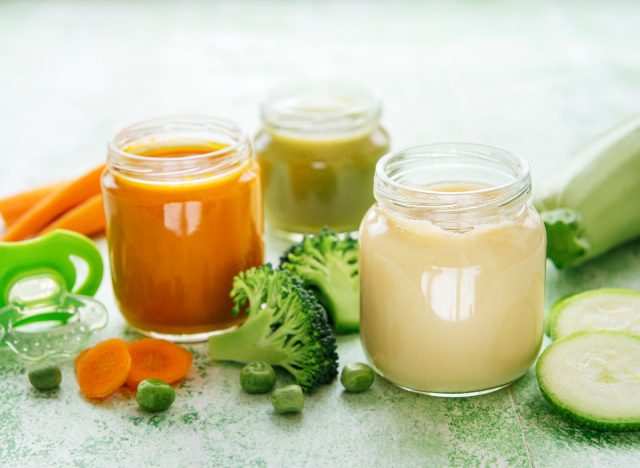
No parent wants to find out that their child's food is hiding an alarming number of neurotoxins, but that's exactly what happened in 2021, when reports revealed popular baby food brands to contain well above the recommended limit for heavy metals, including "91 times the arsenic level, 177 times the lead level, 69 times the cadmium level, and 5 times the mercury level."
The dangers of heavy metals are most prevalent for young, developing children. So it's no wonder that the FDA needed to take action. The guidelines released this year aim to "result in significant reductions in exposures to lead from food while ensuring availability of nutritious foods."
However, change takes time, and it's only a first step in ensuring the safety of baby food. "The guideline does not legally mandate any changes from the food and agricultural industries, so the effectiveness of this guideline is questionable," notes Shapiro.
Until more restrictions are required by the agency, it's a challenge that parents will have to take on. You can start by feeding your child a wide range of high-quality foods and avoiding known formulas with toxic metals.
Fruit Juice
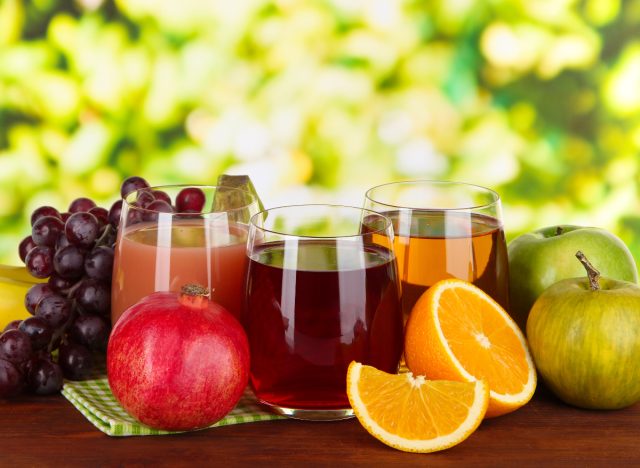
Think twice before you pour that refreshing glass of apple juice. The FDA has been targeting fruit juice as part of its "Closer to Zero" plan to reduce heavy metal exposure for babies and children. The draft guidelines published in April 2022 established the FDA's recommendation that apple juices should not exceed lead levels above 10 ppb, and other juices should not exceed 20 ppb.
However, some experts say the recommended limit isn't low enough to protect children. Linda Birnbaum, Ph.D. and director of the National Institute of Environmental Health Sciences, told Consumer Reports that even juices with 1 ppb of lead or arsenic are still a concern: "It's clear from an abundance of research that there is no safe level for lead exposure."
Rice

This grain is a staple for millions of people because it's widely available, filling, and relatively inexpensive. It's also a popular base for many cereals, which lots of kids consume daily. The FDA guidance aims to limit lead content in dry cereal to 20 ppb.
"Products made with rice, particularly cereals, were the top sources of heavy metals, especially inorganic arsenic," Consumer Reports noted in a 2021 study.
Rice crops absorb about 10 times more arsenic than other grains, according to the nonprofit consumer group. It typically accumulates on the outer layer of the rice, so brown rice contains more than white. But there are other grains you can substitute as better options, like buckwheat, millet, bulgur, barley, and farro.
"Arsenic is in a huge proportion of the global rice supply," Dr. Falcone says. "At very low levels, humans can pretty much tolerate it, but when you're very young, that's when you're most sensitive."
When you do eat rice, you can reduce around 30% of the arsenic contamination by rinsing the rice before cooking, as well as using a 6 to 1 ratio of water to rice when cooking. Consumer Reports also outlined a "7 points per week" system to help children and adults regulate how much arsenic they're taking in from rice on a regular basis.
Dark Chocolate

You don't usually have to feel guilty about indulging in a square of dark chocolate. The varieties with over 70% cacao are loaded with antioxidant-rich and anti-inflammatory flavanols that can help improve heart health, cognitive function, and blood pressure.
Now there may be a reason to watch your intake of this better-for-you dessert. In 2022, Consumer Reports found that there were dozens of popular dark chocolate products with levels of lead and cadmium that exceeded limits set by California, including items from Trader Joe's and Hershey's. From the study, they also identified a few "safer" dark chocolate bars with relatively lower levels of these toxic metals.
According to Consumer Reports, cadmium contaminates the cocoa bean in the soil, where the tree takes up the metal as it grows. Lead can be found on the outer shells of cacao pods, and as they are harvested, the beans themselves accumulate the lead from dust and dirt in the process.
Protein Powder

When it's difficult to get enough of this building block in your food—especially for non-meat eaters—protein powders come to the rescue. But not all protein powders are created equal, and some come with the added risk of toxic metal exposure.
Commercial protein supplements, both whey and plant-based, were found to contain concerning amounts of lead levels in a 2018 study by the Clean Label Project. The study showed that some of the plant-based protein powders had twice the amount of lead, along with levels of arsenic, cadmium, and mercury.
The testing lab's director Sean Callan explained, "This could be due to the locations where the protein powder manufacturers' plant ingredients are sourced having contaminated soil. This is especially true in the United States where there may be a higher incidence of heavy metals in the soil of some regions."
With a little bit of research, you can still find high-quality protein powders with fewer harmful ingredients.
Leafy Greens
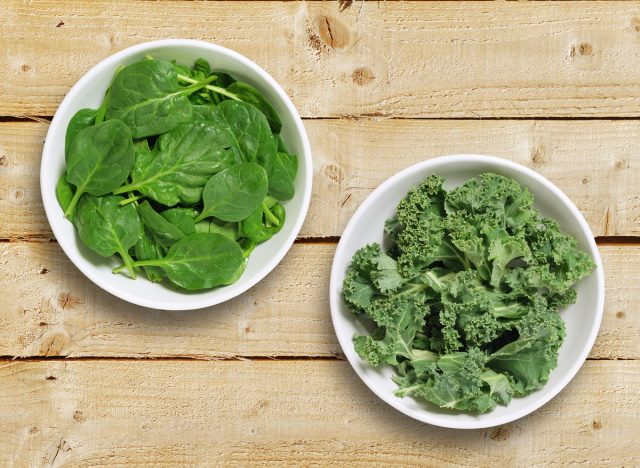
A salad full of leafy greens is a great way to fit tons of vitamins and nutrients in your diet. But beware of a hidden downside to packing your bowl with these fiber-rich vegetables. They're traditionally grown in soil, and when the soil has traces of heavy metals, leafy greens like spinach and lettuce are prone to absorbing them.
According to Dr. Falcone, leafy brassica vegetables—think kale, cabbage, Brussel sprouts—are particularly efficient at taking up the contaminants. "Some plants are good at not accumulating contamination in water or soil. For brassica, [heavy metals] accumulate in the leaves," he says. "They're called hyperaccumulators, so they concentrate the components in the plant in a bioremediation process to take up the heavy metals from the soil to decrease its levels."
Consumers have just started to find out just how much of the toxic metals can be found in their food sources. In December 2021, an effort by the nonprofit group As You Sow to "promote environmental and social corporate responsibility" revealed dangerous levels of cadmium in spinach sold by large retailers like Safeway, Trader Joe's, and Target.
The metal was present in standard and organic spinach products. As You Sow urges people to voice their concerns directly to companies, in order to push regulation changes for the better.
Root Vegetables
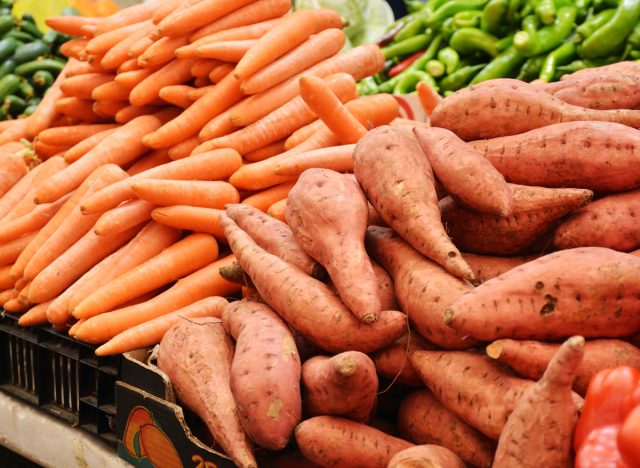
Sweet potatoes and carrots are also susceptible to soil contamination. Root vegetables are considered at higher risk for containing heavy metals, according to Consumer Reports. Buying all-natural or organic doesn't make much of a difference, either, CNN Health reported, since the methods for organic farming also use soil and water.
The amount of toxic metals can be vastly inconsistent. CNN Health found that one sweet potato contained ten times more than a store-bought sweet potato puree, and it can be difficult to determine what factors affect the discrepancy.
It's still a good idea to incorporate these foods, because they do provide health benefits. "Carrots and sweet potatoes are sources of important nutrients like beta carotene, potassium, and fiber, and you can feed them to your child in rotation with other vegetables," said Consumer Reports nutritionist Amy Keating, RD. "What's key is eating a balance of healthy foods."
Spices
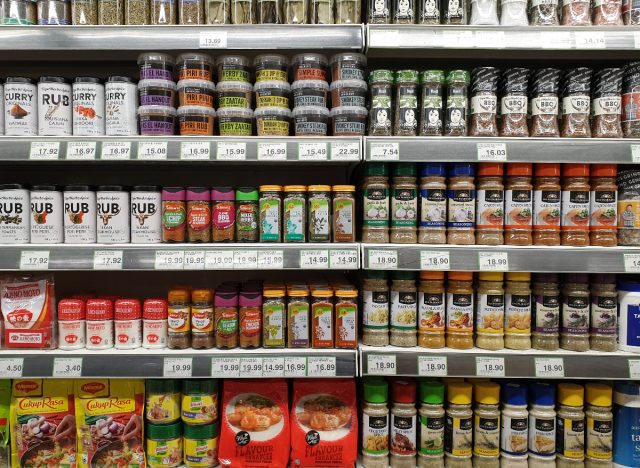
We add flavors to our dishes to make eating more enjoyable. Some seasonings, like turmeric and ginger, even come with added health benefits. But there's a reason you may want to lay off the spices. Consumer Reports tested an array of products from large retailers and saw that nearly one-third had dangerous amounts of arsenic, lead, and cadmium. Fortunately, the majority of spices didn't exceed test limits, so it's not a sign to ditch your seasonings altogether—just to be cautious.
You should also be on alert when evaluating supplements. Turmeric, for example, is available as an anti-inflammatory supplement, but since the FDA doesn't regulate these products, it can be challenging to know if you're getting a good one. Consumer Reports recommends looking for a third-party testing label to ensure it hasn't been contaminated with lead before you add it to your regimen.
Fish

Despite its health advantages, most consumers are aware that fish can't be eaten daily. Because of pollution, a mercury compound called methylmercury accumulates in seafood sources in potentially dangerous amounts.
Mercury contamination passes through the fish food chain, originating in their food sources like algae, which readily absorbs in the toxins in the water. It's not uncommon for people to have high blood mercury levels. One study showed that, out of 89 people in the U.S., 89% had excessive mercury in their blood, according to Healthline. The side effects of eating too much mercury include neurological impairments like hearing, vision, and coordination challenges and muscle weakness.
To reap the benefits of heart-healthy Omega-3s and protein found in seafood, avoid eating types of fish that accumulate mercury frequently (yellowtail, swordfish, tilefish) and opt for ones that tend to have lower levels of mercury (sockeye salmon, Atlantic herring, canned sardines).
Bone Broth
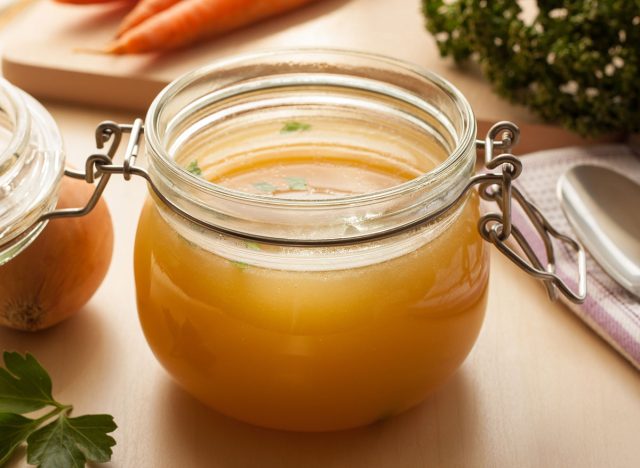
The flavorful soup base is thought to have ample benefits, providing minerals, collagen, and protein to help with nutrition, gastrointestinal function, and weight maintenance.
But adding a cup of bone broth to your routine isn't without its risks. As the bones get simmered down to release all of the good iron and magnesium, you may also be infusing the stock with dangerous metal toxins.
Concerning amounts of lead can be sequestered in the bones of farm animals, which leaches out into the broth. A 2013 study found that, even in organic sources, lead could be seen at noticeably high levels in bone broth compared to the tap water with which it was cooked.
It's true that bone broth does wonders for your health, so if you want to incorporate it into your diet to support your musculoskeletal and digestive well-being, stick to drinking it in limited amounts.
No comments:
Post a Comment